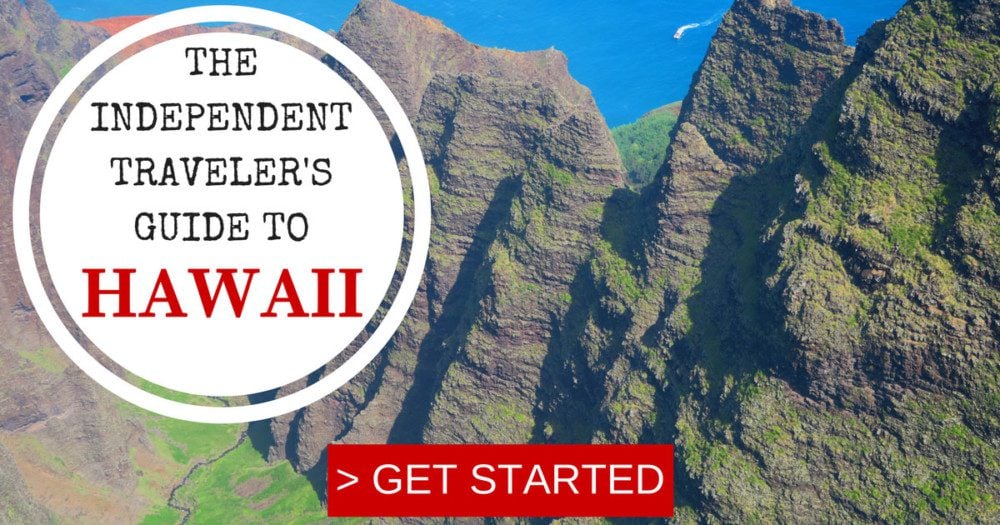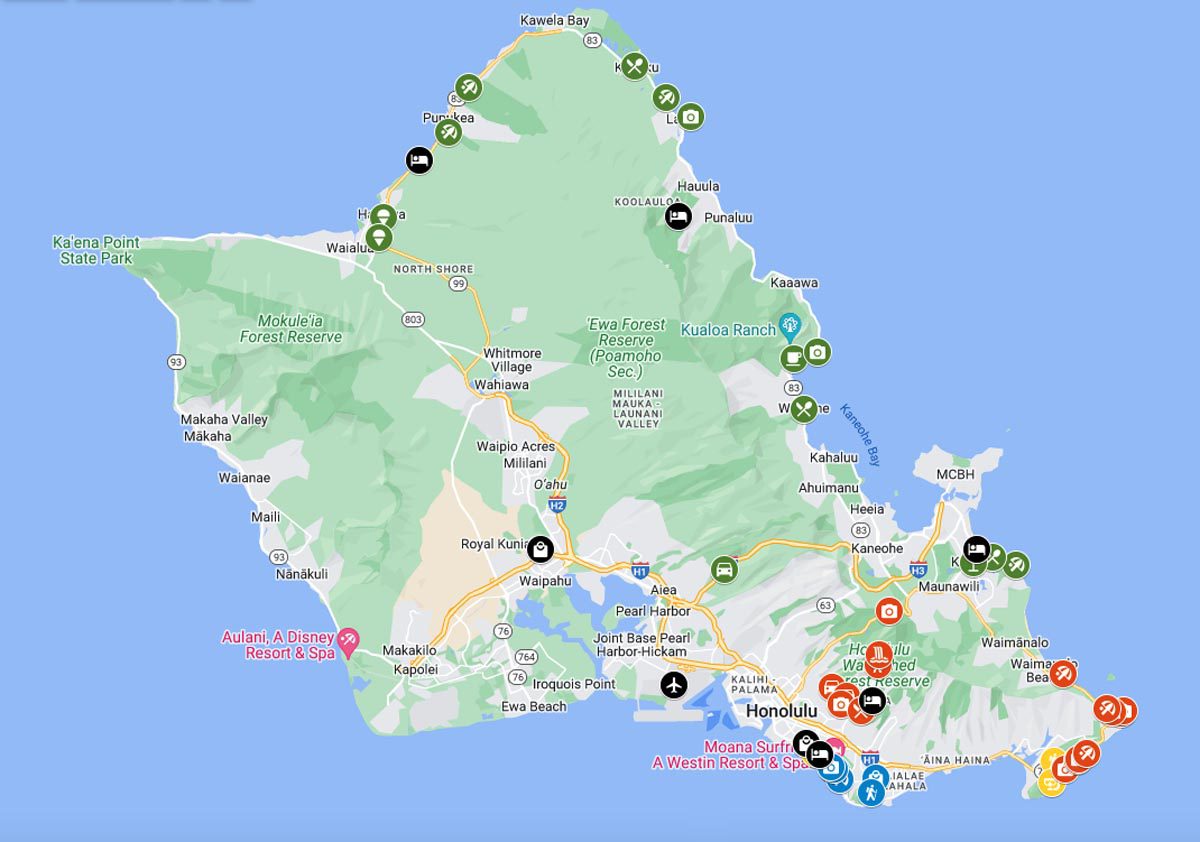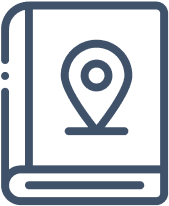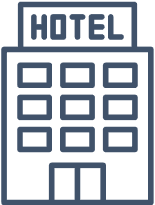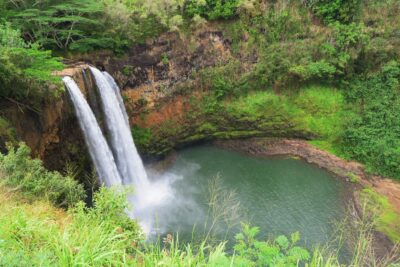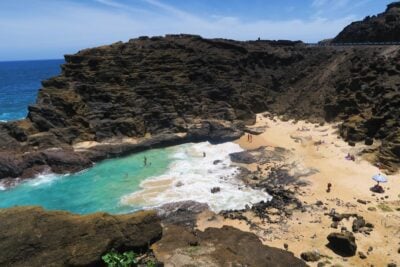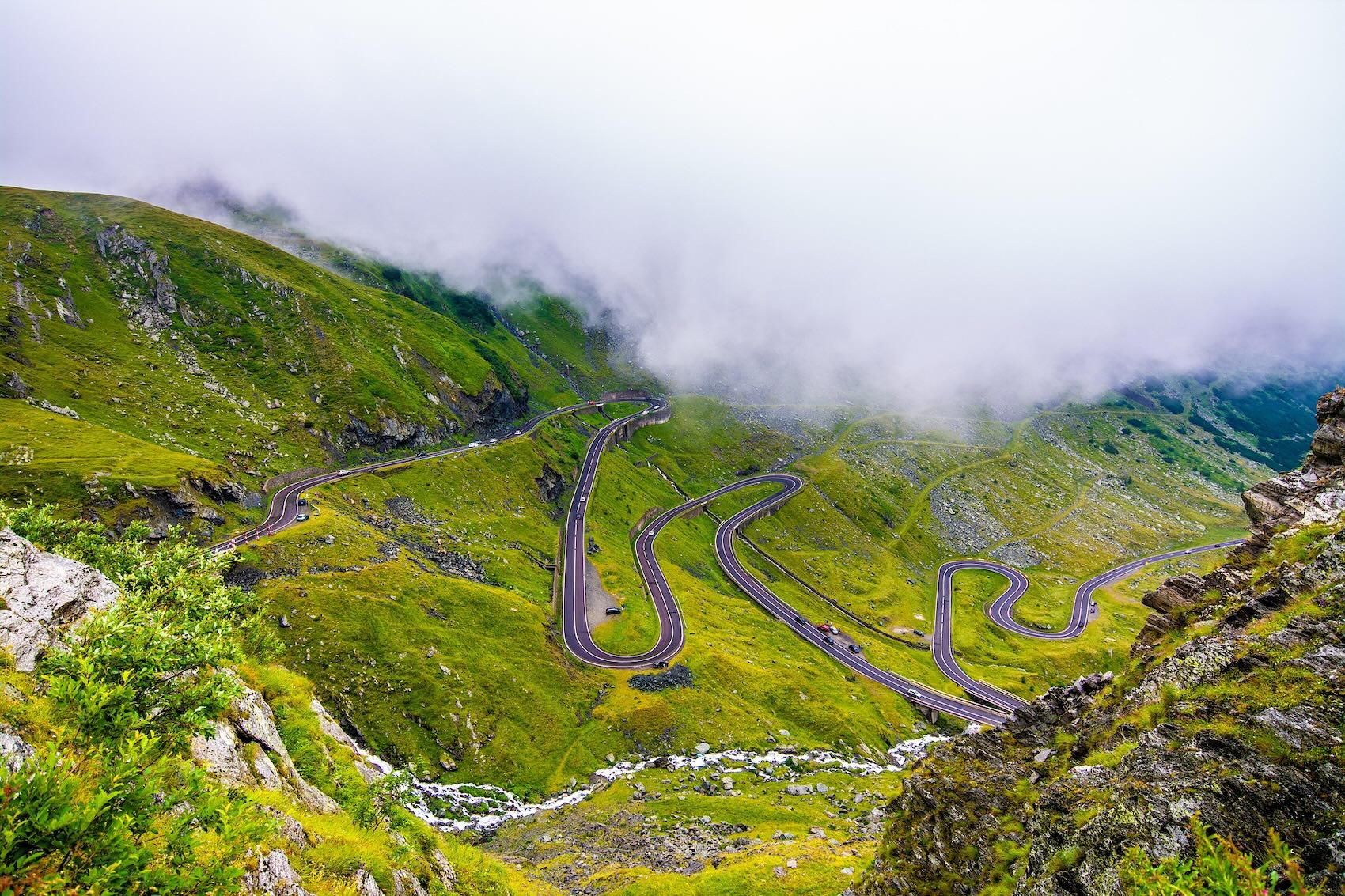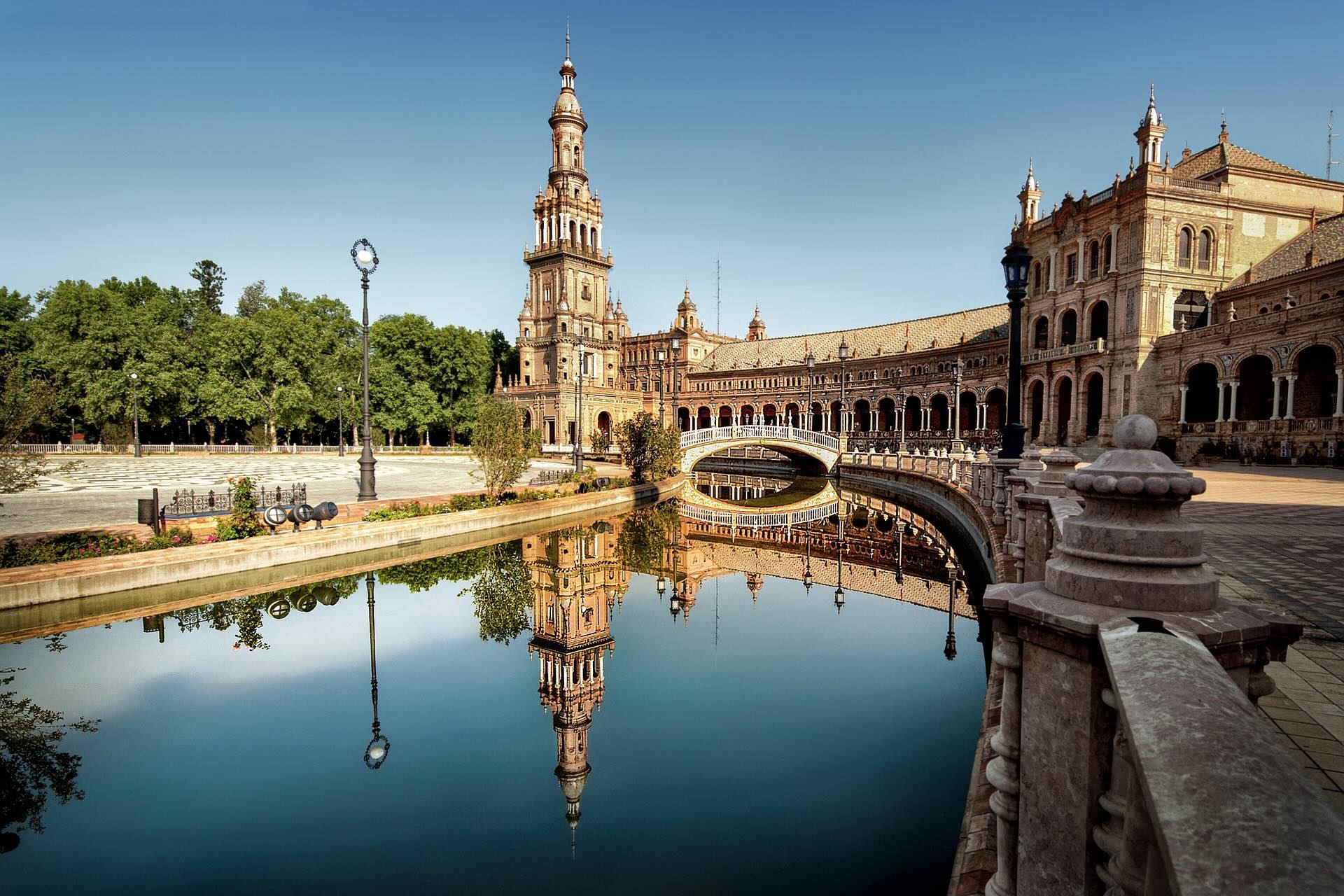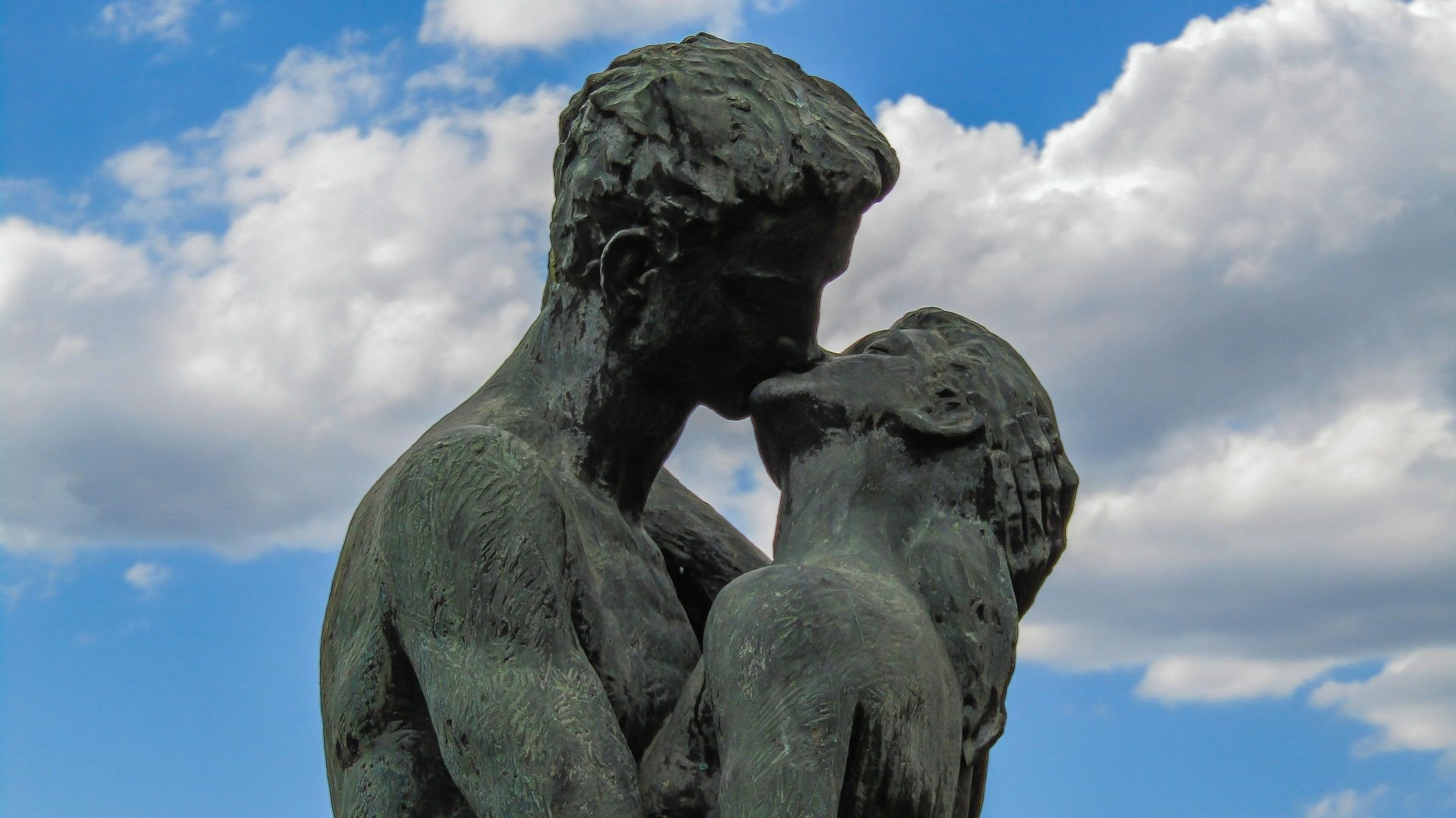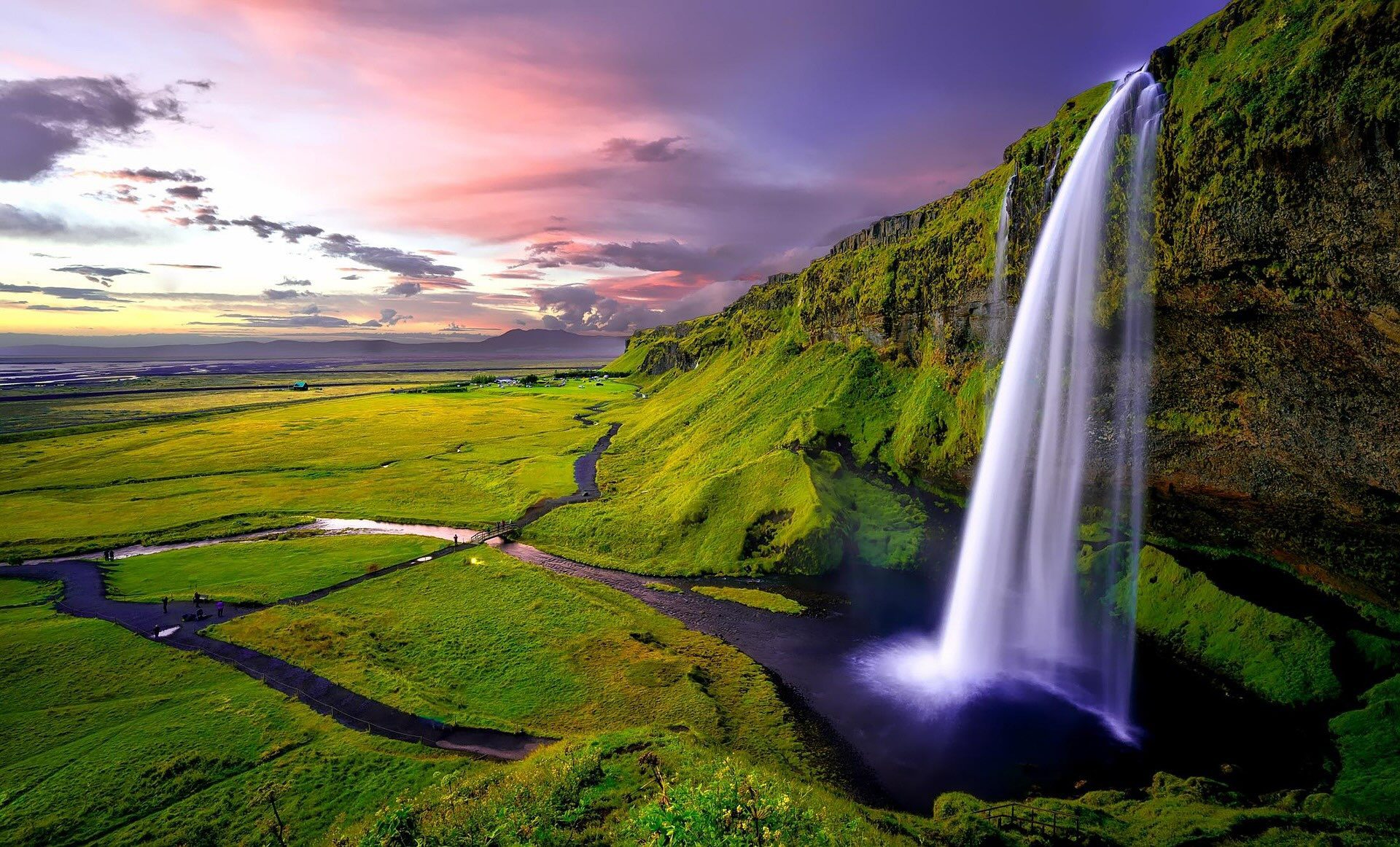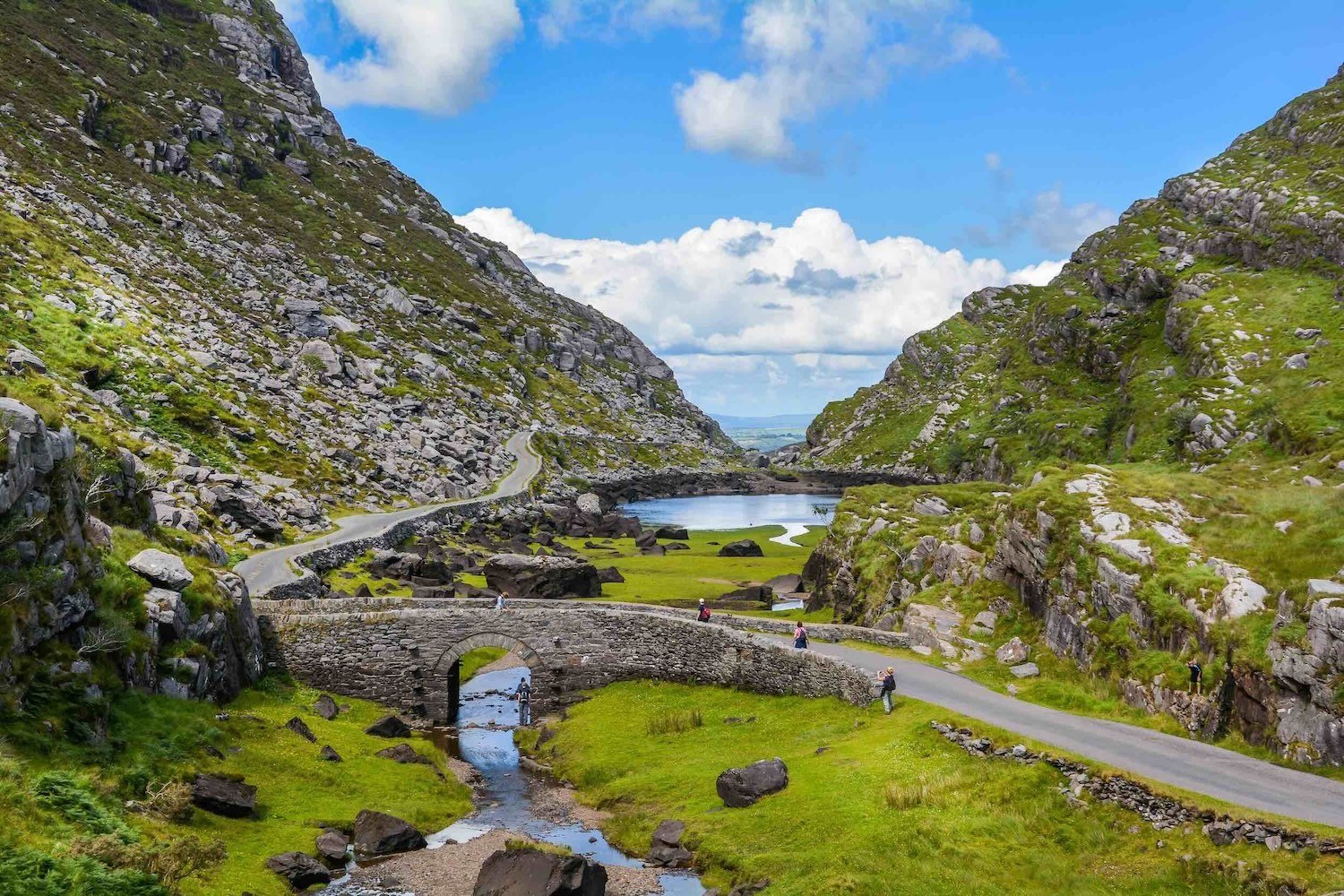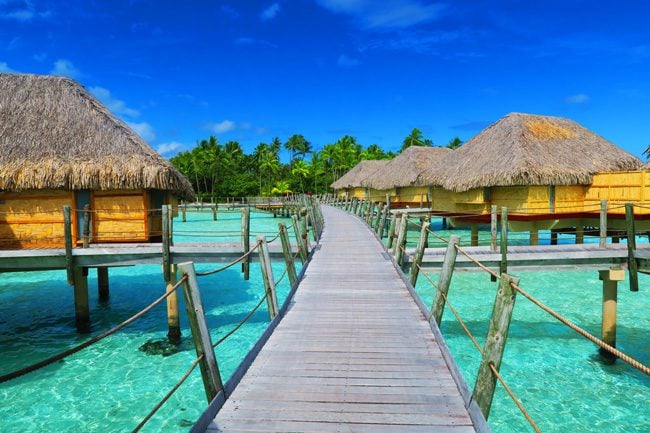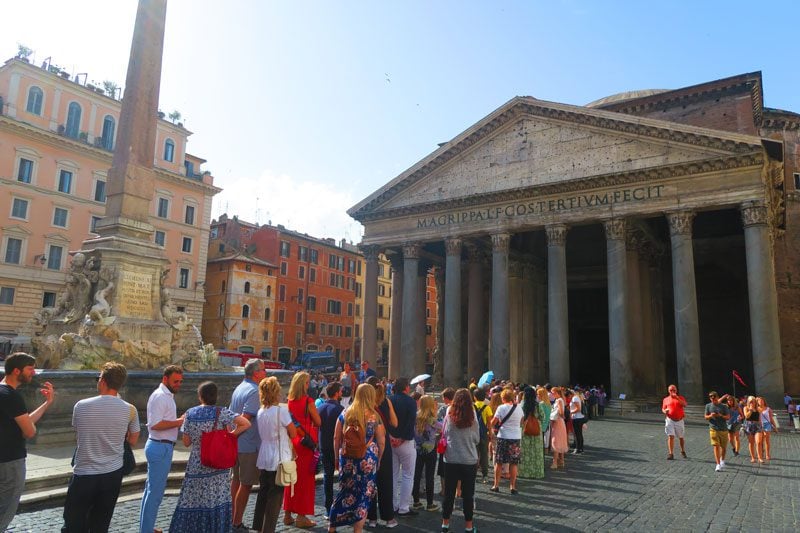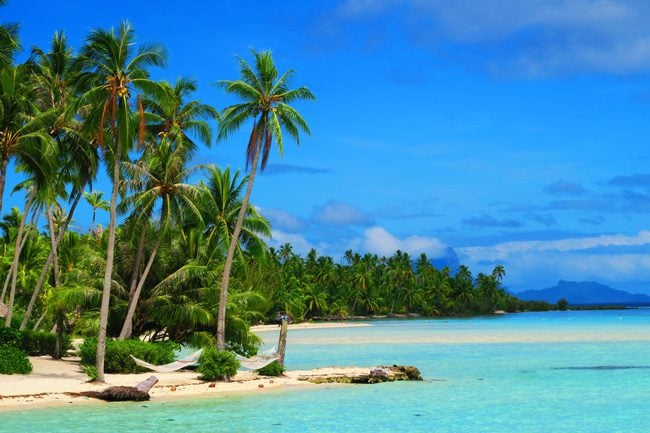4 Days In Honolulu & Oahu Itinerary
Oahu is Hawaii’s main international gateway, often overlooked by visitors in transit to the archipelago’s more “rugged” gems. Home to Honolulu, the state’s capital and only proper city, there’s more to Oahu beyond Waikiki’s concrete jungle. With volcanic craters dotting the coastline, magnificent beaches, and the signature eroded peaks of the Pali Coast – Oahu may possibly be the most beautiful island in Hawaii if it weren’t for its exploding population. In this Honolulu and Oahu itinerary, we’ll explore the island’s best spots and balance between urban experience the laid back country life.
I spent a week in Honolulu and Oahu while exploring the main Hawaiian Islands. It often reminded me of my visit to Tahiti in French Polynesia. Tahiti shares similar demographics and the “in-transit” mentality of Oahu, and the two often share stunning geographic features. It’s often nice to have the modernities of a proper city, but Oahu’s added value is that once you leave the big city behind on a road trip, the island’s beauty is remarkable.
Before we begin, it’s important to note that Honolulu and Oahu’s tour operators offer a wide selection of excursions and activities, as you might expect from the busiest island in Hawaii. However, in this Oahu itinerary, we’ll stick to basics and mostly concentrate on activities that you can do independently.
Why Visit Honolulu & Oahu?
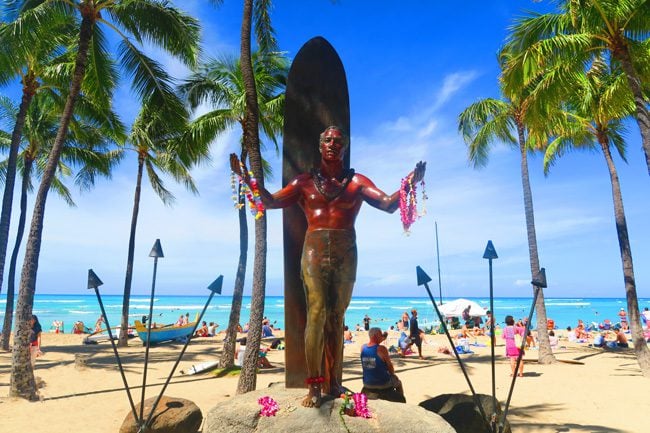
Home to world-class museums, monuments, and historical buildings, learn about Hawaii’s history and America’s bravery on your visit to Oahu.
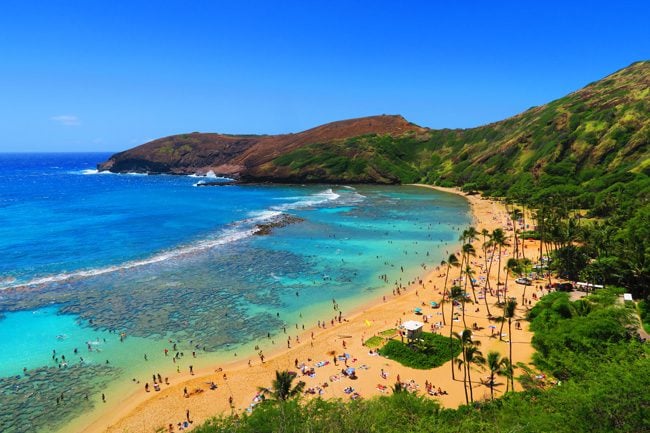
Hit the road, leave the big city behind and explore Oahu’s stunning scenery. Along the way, visit beaches, roadside stalls, and enjoy the views at scenic lookouts.
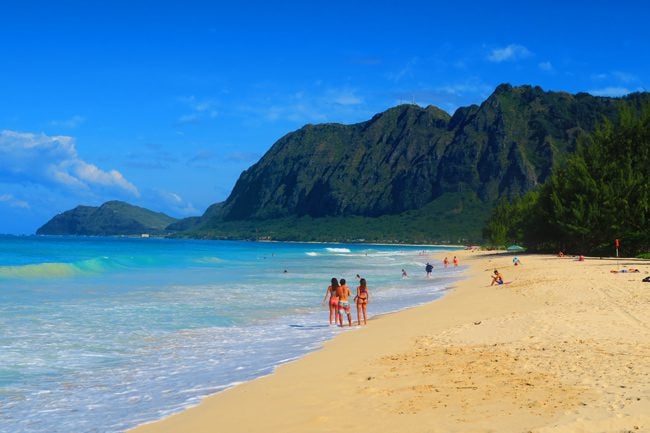
Oahu’s North Shore is a world of its own, so different than the hustle and bustle of the city. Out here, wide beaches are home to massive waves only the bravest dare to conquer.
- Day 1: Essential Oahu Tips, Diamond Head and Waikiki Beach [This Page]
- Day 2: Pearl Harbor or Koko Crater & Hanauma Bay
- Day 3: Manoa Falls & Southeast Coast Road Trip
- Day 4: Pali Coast & North Shore Road Trip
Additional Resources
Visiting other Hawaiian islands? Sample itineraries, guides to the best beaches and lots more are waiting for you in the Hawaii Travel Guide collection. Aloha!
Honolulu & Oahu Itinerary Map
This map features all the places mentioned in this Oahu itinerary. Click on the image to open in Google Maps.
Honolulu & Oahu Travel Tips
This section of the Honolulu and Oahu itinerary covers essential planning tips. Also, go over what you need to know before visiting Hawaii, where you’ll find general advice on visiting the Hawaiian Islands.
When is the Best Time to Visit Honolulu & Oahu
Oahu and Honolulu are year-round destinations, busy with tourists throughout the year. However, weather and peak tourist seasons will affect your stay nonetheless. Generally speaking, the best time to visit is on either side of the summer break.
Oahu’s weather
The weather on Oahu dramatically varies between the windward and leeward sides (in general, north vs. south). If it’s raining on the north shore, there’s a very good chance Honolulu is baking in the sun. That said, the island sees drier weather during the North American summer and wet weather during the winter months. Shoulder seasons are always a good time to visit (Apr-May, Sep-Oct).
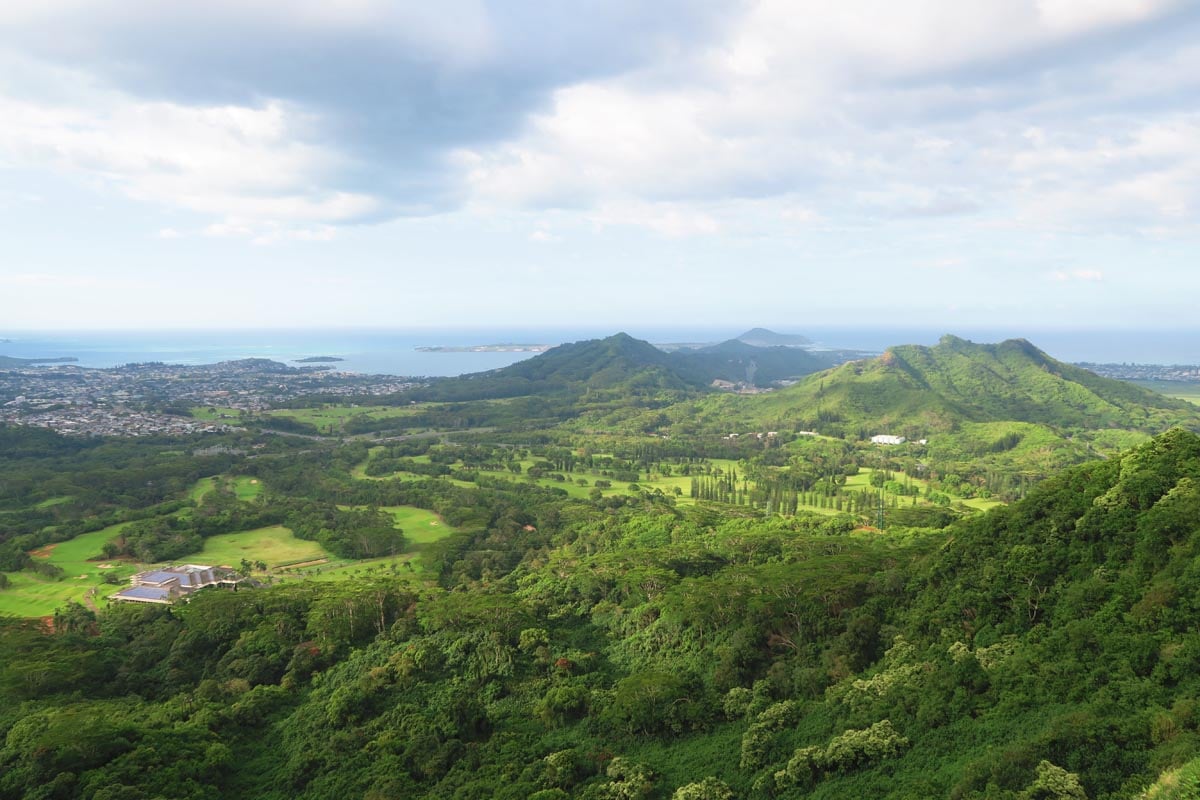
Oahu Peak Tourist Season
Apart from the steady barrage of organized tours crisscrossing the island, Oahu gets an extra dose of visitors during the U.S. holiday seasons (Christmas, New Year’s, Easter, etc.) and school holidays (spring and summer breaks). It’s best to avoid these periods or secure your flights and accommodations early.
Where to Stay in Honolulu & Oahu
Oahu is small enough, and its network of roads is efficient enough (albeit gridlocked at times) for it to make sense to base yourself in the Honolulu area for your entire stay on the island. I’ll list two recommended areas in the city. Still, if you’re looking for a place to stay outside Honolulu, Kailua is the best option. Hauula is further out and quieter, and Kawailoa Beach is perfect for staying close to mighty north shore waves.
Here’s a link to a complete list of Honolulu accommodations that you can book online via Booking.com.
Waikiki Beach Area
Waikiki is the place to see and be seen. It is the perfect choice if you want to stay smack in the middle of the action. Accommodations in Waikiki primarily consist of high rises, luxury beachside hotels, and furnished condos. For a quieter stay, look for places in the residential area between Waikiki and Diamond Head.
Keep in mind three things if choosing to stay in Waikiki Beach: (1) free parking is rarely included, (2) a resort fee and sometimes even a cleaning fee will be added to the price, so carefully read the fine print, (3) this will not be a quiet stay, but you will be close to the beach, shopping, and dining, and the nightlife scene.
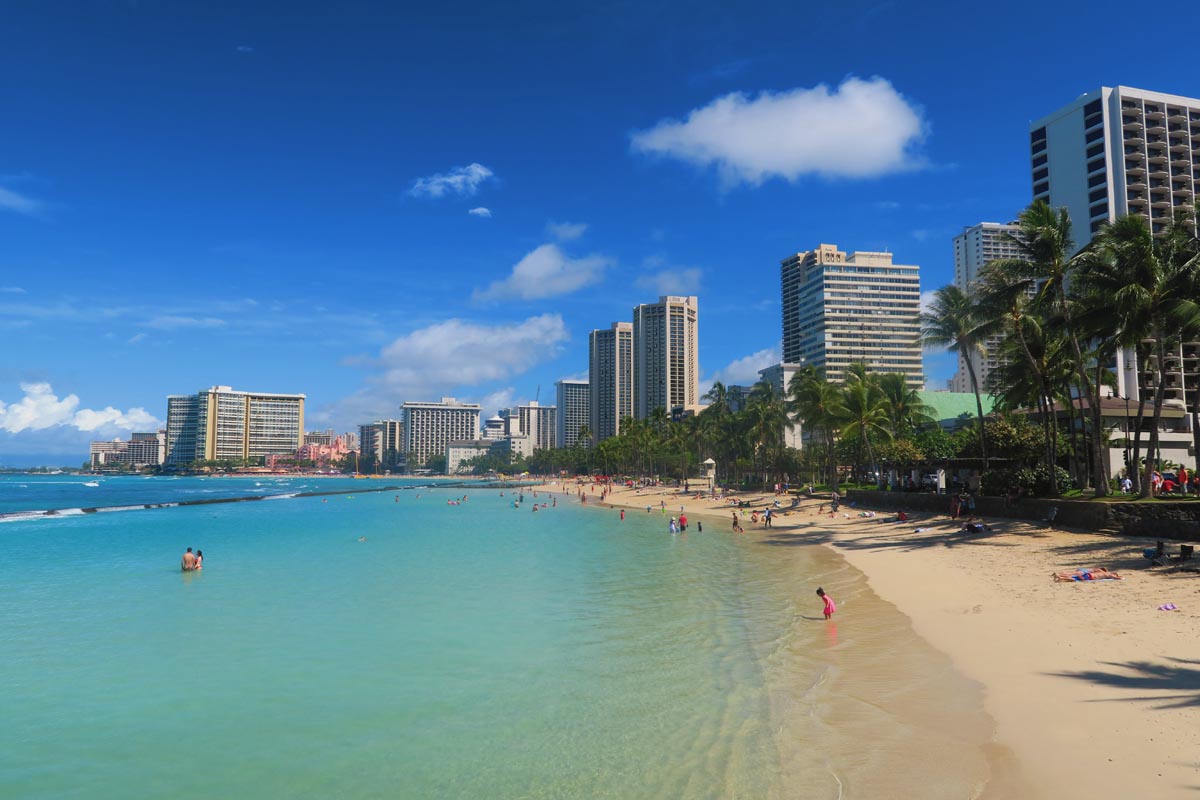
Manoa District
The Manoa district is an affluent residential neighborhood of Honolulu, nestled at the base of the beautiful mountains that shield the city from the trade winds. The area boasts many dining options and is a short drive from Waikiki and the network of interstate highways. The only downsides are the lack of nightlife and the absolute need for a car (which I recommend having in any case…).
Backpacker Hostels
Most of the backpacker hostels in Honolulu are in Waikiki Beach. They tend to be quite large establishments and naturally offer backpackers activities to keep them busy. I advise booking well in advance because the good ones fill up quickly. Your other alternative is to look for inexpensive Airbnbs in the Ala Moana area.
Here’s a link to a complete list of Honolulu accommodations that you can book online via Booking.com.
Getting Around Oahu
The best way of getting around Oahu depends on what you want to see and do on the island.
Oahu by Bus
Oahu’s extensive bus network, TheBus, serves most parts of the island for a relatively low fare. If you’re just staying in Honolulu and wish to go to a specific beach/attraction outside of town, using the bus should be just fine for point-to-point travel and you won’t need to rent a car. You can also use the bus to get to/from the airport or use an airport shuttle/Uber.
Buses on popular tourist routes can be completely full even on weekdays, with drivers not picking up additional passengers along the way (for example Waikiki to Hanauma Bay). Use apps like Moovit to optimize your bus travel.
Oahu By Car
If you’re out to properly explore Oahu, I highly recommend renting a car either for your entire stay or for dedicated sightseeing days outside Honolulu. There is a lot of competition over tourist dollars so you can get great deals on rentals (plus the gas is the cheapest in the state).
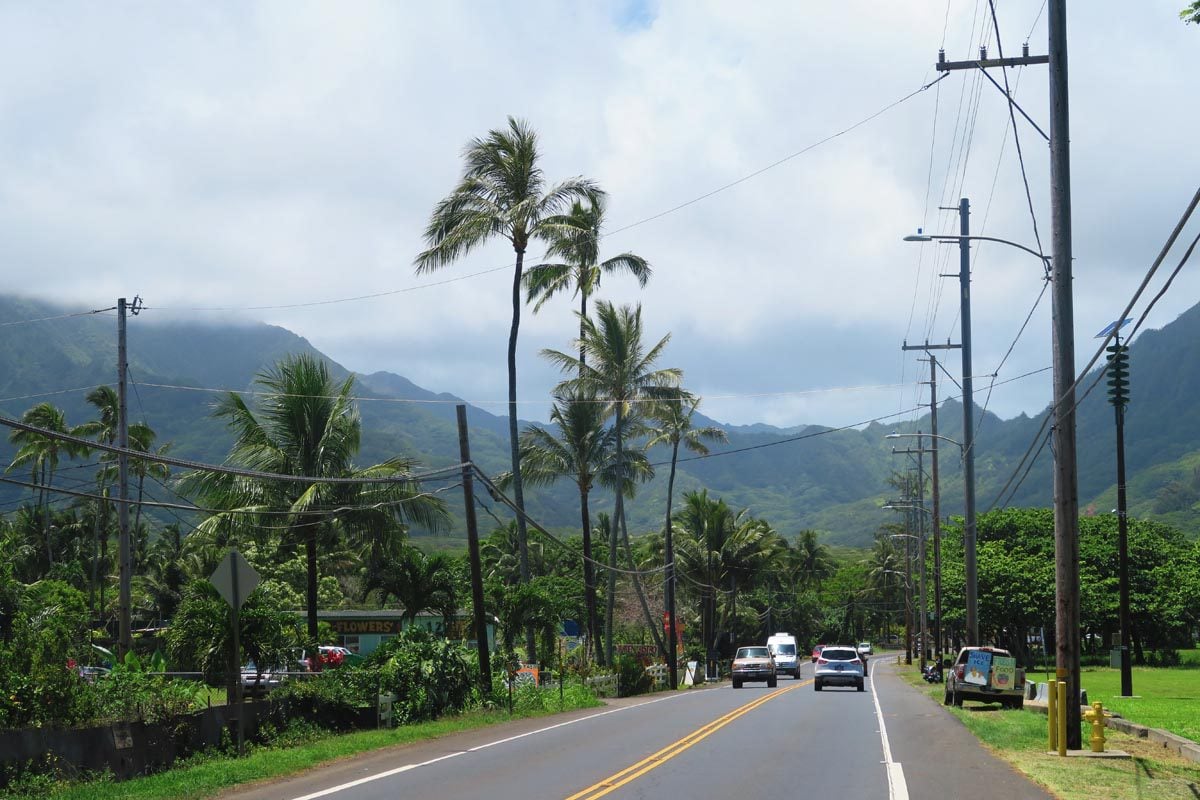
Oahu Driving Tips
Here are a few key things to consider when exploring Oahu by car:
There is no need to rent a 4WD in Oahu, as you’ll likely only drive on paved roads.
Traffic is a real issue on Oahu, with roads often congested in the morning and afternoon rush hours, plus on weekends and holidays. In addition, when “country” roads are being repaired, traffic is reduced to either one lane in each direction or in total. I highly recommend using navigation apps such as Waze or Google Maps to outsmart traffic as much as possible.
Parking is expensive in the Waikiki Beach area and will set you back at least $30 per day. Once you leave the downtown area and the city, there isn’t a problem.
Car break-ins are quite common in Hawaii. Avoid leaving your car in isolated areas, and never leave anything visible in the car. Also, inspect the parking area for broken glass, a definite sign to park elsewhere.
Since Hawaii is a ‘no-fault’ state, car rental companies will scare you to death and offer expensive insurance plans. With the larger companies, you can usually decline this, but with the smaller ones, they often force you to take, at the very least, the “cheapest package”. American car owners usually have an insurance policy that covers rental cars, but foreigners do not. If you’re traveling from abroad, car rental platforms such as Rentalcars.com offer comprehensive insurance for a low cost.
The island of Oahu boasts many attractions and endless special experiences, ranging from scenic helicopter flights to Polynesian cultural activities. Browse through this list of Oahu attractions and unique experiences, suitable for families, adventure seekers, and history buffs. Aim to purchase your tickets in advance, especially for popular tours with limited capacity.
What to Pack for Honolulu & Oahu
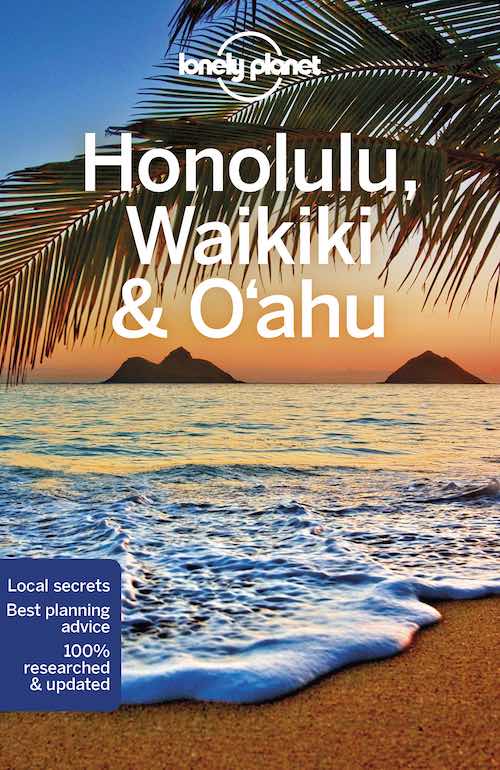
If you’re just heading to Honolulu, a good pair of walking shoes and beach gear is all you need. However, to properly explore Oahu, be ready for the beach with reef shoes and snorkeling gear. For hikes, pack proper shoes, walking poles, and quick-drying clothing. Make sure you have USB chargers and anything else for road trips to make the drive comfortable.
With this Oahu itinerary, I also recommend grabbing a Lonely Planet Guide to the island and, if visiting other islands, perhaps also Lonely Planet’s Best of Hawaii. These guidebooks provide useful information at your fingertips and give a better understanding of Hawaii’s culture and history.
Have a look at this page for packing recommendations.
Shopping in Honolulu
As you might expect from the most populated island in Hawaii so frequented by tourists, Oahu and Honolulu boast a welcoming shopping scene. Though there are surely more options, here are three recommendations:
- Kalakaua Avenue in Waikiki Beach: good for “tacky” and high-end souvenirs, unique surf clothing, and luxury stores.
- Ala Moana Center: Honolulu’s premier shopping experience. You’ll find here several department stores, all the top U.S. mainstream and luxury brands, and an extensive food court.
- Waikele Premium Outlets: the quintessential U.S. shopping experience, this “Premium Outlets” member is located about 30 minutes west of Waikiki, with a paid shuttle service connecting the two.
Staying Safe in Honolulu & Oahu
Here are a few key safety tips. Remember to check out the “Oahu Driving Tips” section for specific safety tips for drivers.
In Honolulu, avoid walking in the downtown area and large parks at night (Waikiki is OK). This specifically includes the Chinatown area, which is also sketchy during the daytime. Honolulu has a crime and drug problem for several reasons, and it is best to exercise caution and inquire with your hosts before venturing into the urban area.
Oahu’s beaches can be hazardous during periods of high surf, especially on the windward side. Exercise caution and never swim out too far. Shark attacks have been known to occur on Oahu’s beaches. You cannot do much, but just be aware and ask the locals.
Oahu’s remote West Coast is sparsely populated, and mobile reception may not be adequate. Be sure to fill up the gas tank and have offline access to Google Maps.
Day 1: Diamond Head and Waikiki Beach
We’ll stick around the big city on the first day of this Oahu itinerary to visit two of Hawaii’s most iconic sites.
Logistics for the day
I recommend starting relatively early and visiting Diamond Head before Waikiki Beach. The crater is one of the most visited sites in Hawaii, and it tends to experience intensely hot weather by midday. So pack light hiking gear (sandals ok) and beach gear to avoid having to return to your accommodation in between.
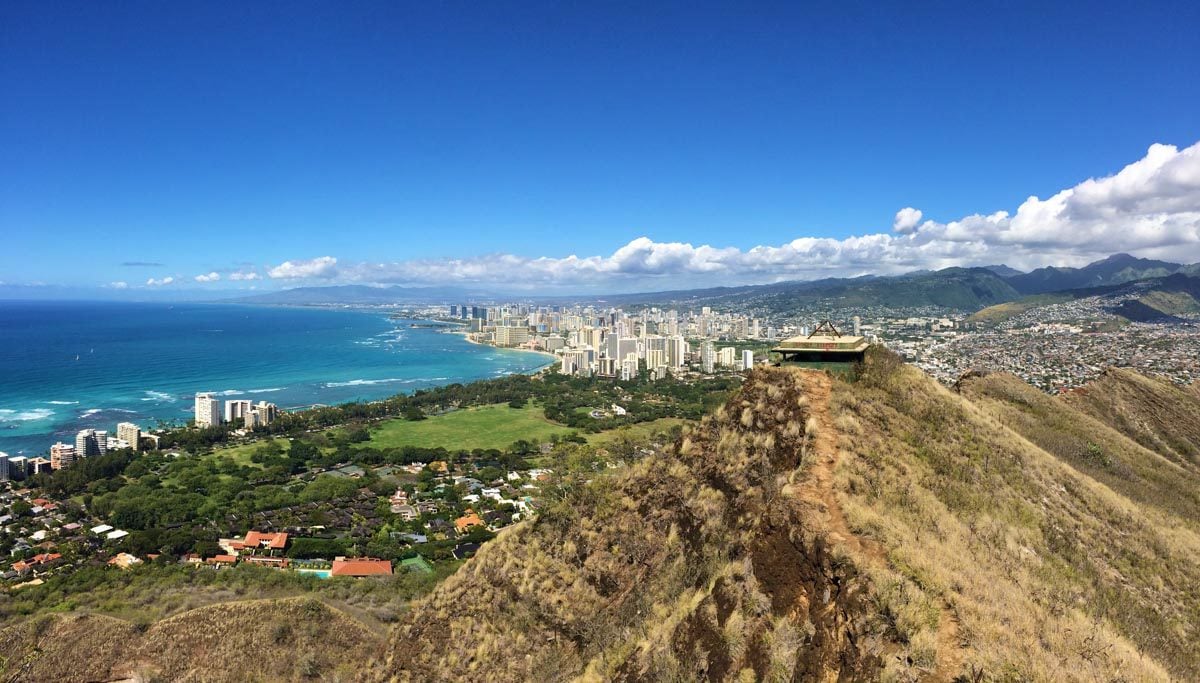
Morning in the Market
If it happens to be Saturday morning, start the day at the KCC Farmers Market – considered the best farmers market in Oahu. On other days, check if any farmers market is taking place (link). If you’re an early riser, inquire about the Honolulu Fish Auction. It’s a highly unique experience that showcases the Pacific Ocean’s bounty. The auction occurs six times per week, with guided tours offered on Saturdays. You can even come here for lunch.
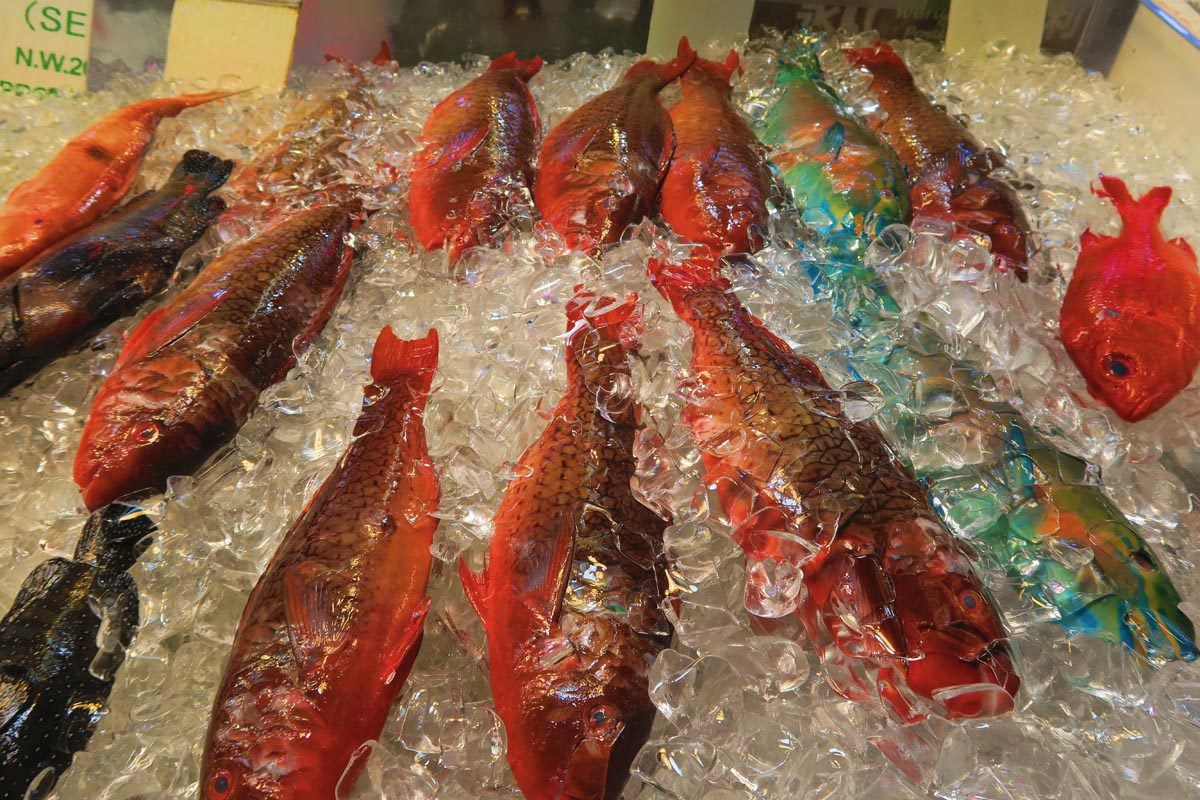
Hike in Diamond Head Crater
Strategically located on the sunny coast overlooking Waikiki Beach, Diamond Head is the symbol of Oahu and Hawaii’s most recognized landmark. The crater was formed by a relatively late eruption of one of Oahu’s ancient shield volcanoes. As magma met groundwater and created steam, ash, coral, and pyroclastic debris blasts created tuff cones such as Diamond Head and Koko Head (see tomorrow’s itinerary). Don’t forget to book your entry in advance.
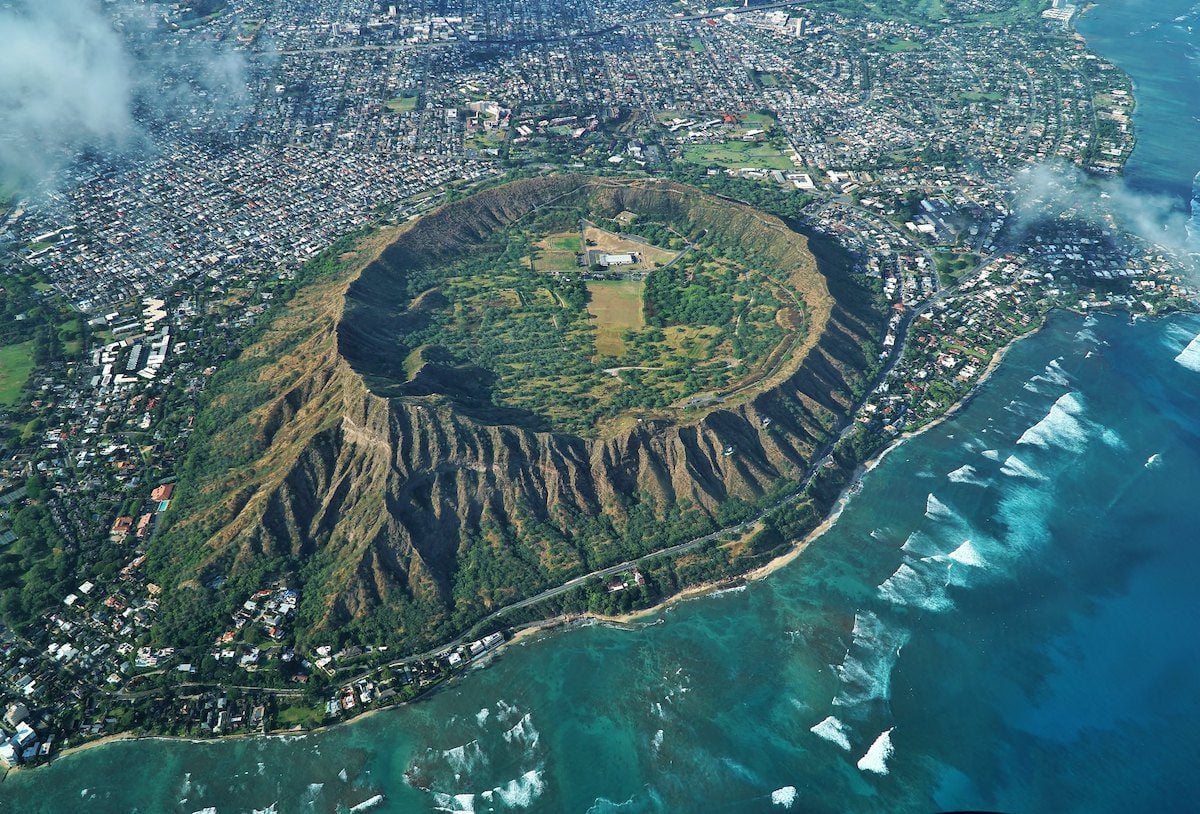
Historical Significance
Known as Le’ahi to Hawaiians, Diamond Head was a spot of spiritual significance that immediately drew the attention of the first Westerners. These early explorers mistook the calcite crystals found on the crater’s slopes for diamonds, and that’s how its present name came to be.
As the U.S. increased its presence in Hawaii, Diamond Head became an ideal location for the island’s coastal defense system. In 1908, the army constructed a trail leading to the summit. On the slopes and the summit, artillery stations were constructed, and even a firing station was built to coordinate the launch of long-distance shells in the event of a marine invasion.
Hiking Diamond Head
Hiking to the summit of Diamond Head is an absolute must. You can drive inside the crater floor and park your car, but a much more scenic route is to simply walk from Waikiki or park on its slopes and walk to the visitor’s station. From here, you’ll pick up the 0.8-mile (1.3 km) trail (one way) and hike to the summit.
Along the way, various lookout points offer sublime 360-degree views of the area, primarily north to the Koʻolau mountain range and east toward Koko Head (see day two itinerary). However, it is the view from the summit that is the most rewarding – a nearly unobstructed view of the Waikiki Beach coastline and (unfortunately) its endless collection of high rises.
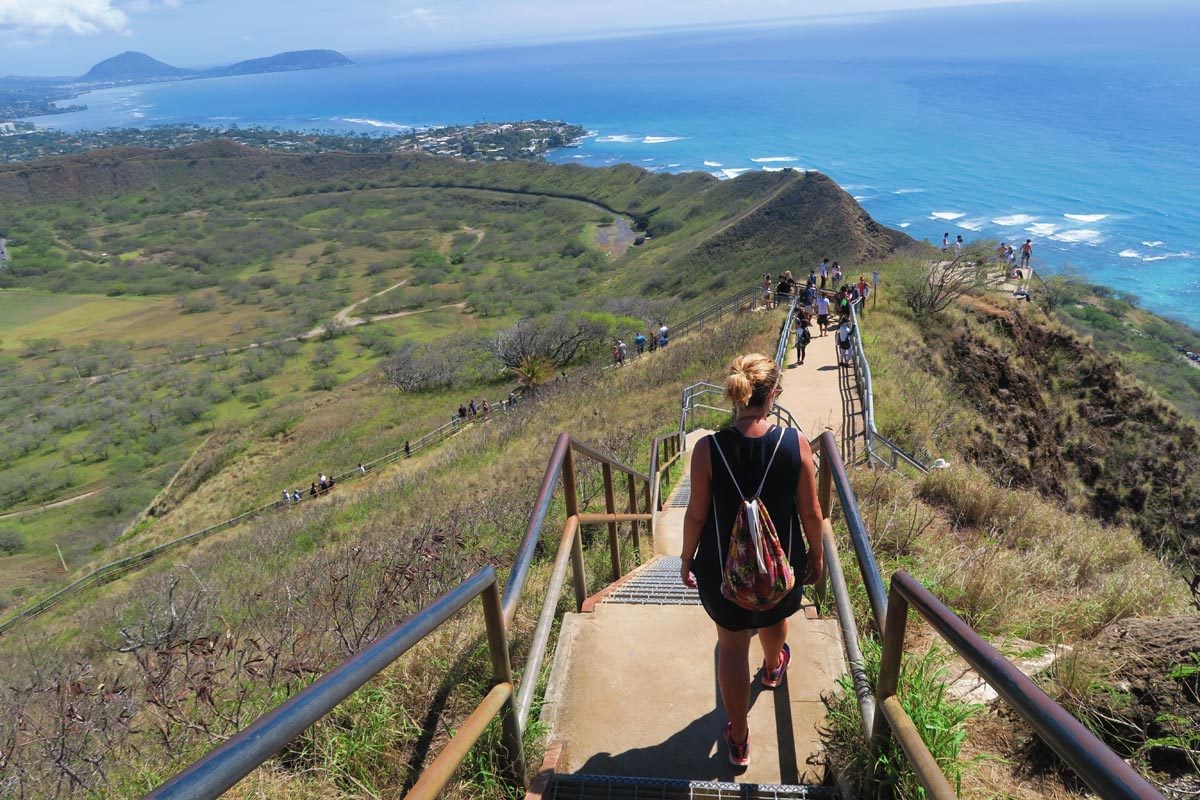
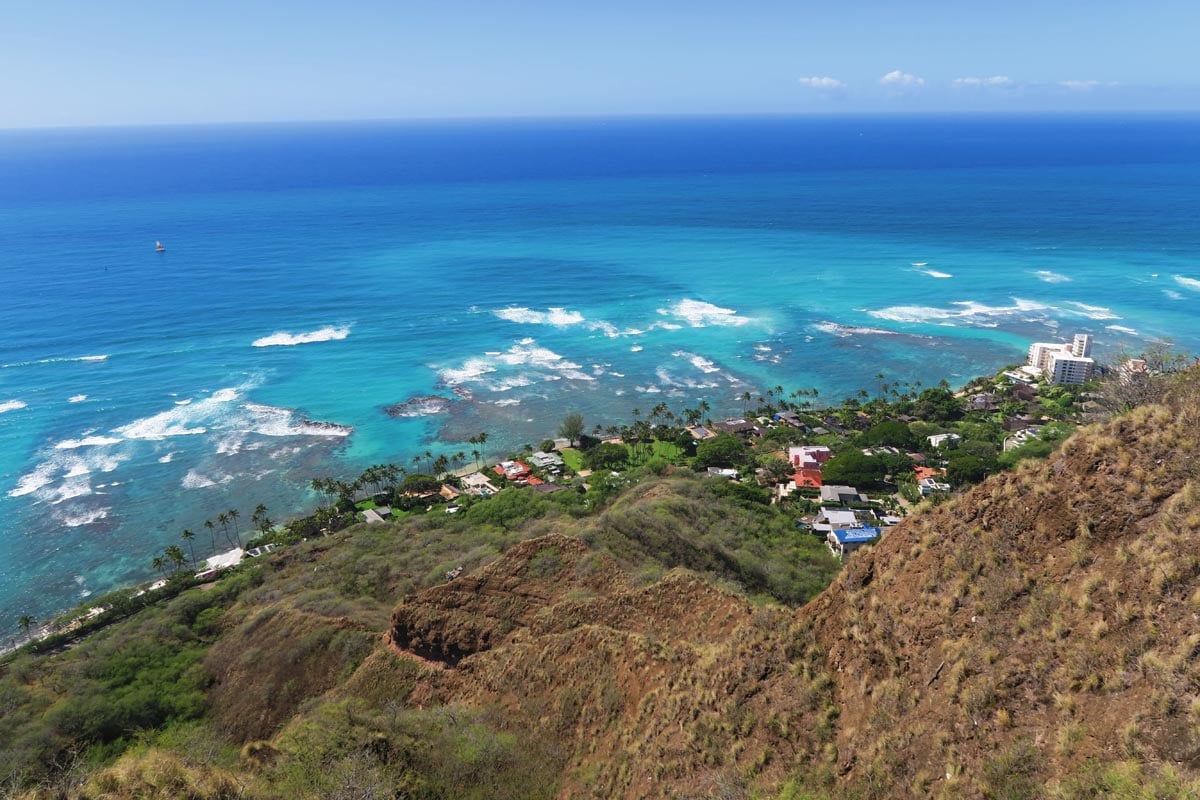
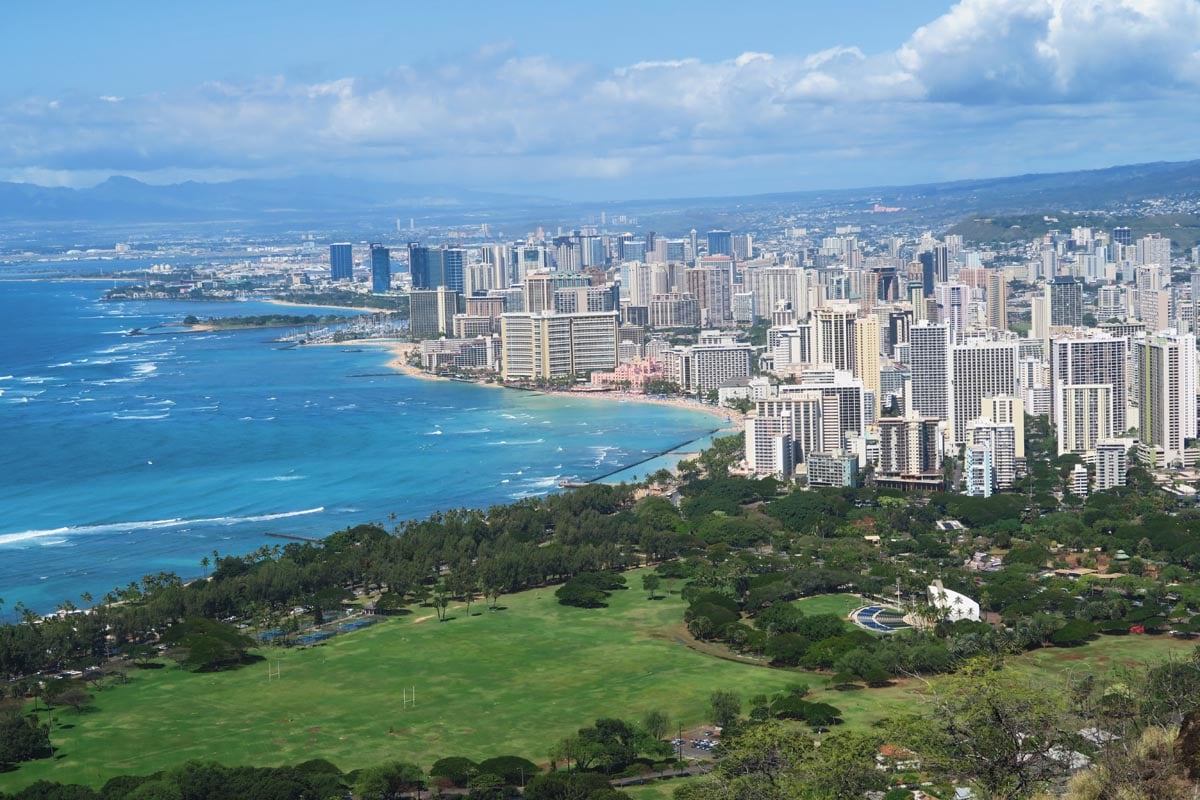
Logistics
The hike takes about 1.5-2 hours, including all the scenic stops. It can get quite steep at times, though it is not over-challenging. If you don’t start early, the trail will be crowded, and sections might be slow going. Due to the crater’s unique position and shape, it is very sunny and gets extra hot until you reach the summit breeze. Put on sunscreen, don’t forget to wear a hat and drink lots of water. There are restrooms and food trucks at the visitor’s center, where you should also pick up a trail map.
Waikiki Beach & Around
Love it or hate it, it’s difficult to visit Honolulu without paying a visit to Waikiki Beach – one of the most famous beaches in the world. Since we’ve just enjoyed an incredible bird’s eye view of Waikiki from Diamond Head, spending the rest of the day on this famous stretch of beach makes perfect sense.
If you want to stick around Honolulu but looking for a quieter spot other than Waikiki Beach, head to Ala Moana Beach Park. It’s pretty much right next to Waikiki Beach and frequented by locals. Another plus is the nearby Ala Moana Center, Honolulu’s premier shopping experience where you’ll also find a large food court and a supermarket.
Background
The area known as Waikiki Beach was frequented by Hawaiian royalty in the old days, to “escape the city”. It was also a prime farming area with wetlands and taro fields. Things started to change in 1901 with the opening of the first hotel, which we’ll soon visit, and Waikiki pretty much never looked back, for better or worse.
These days, Waikiki is the place to see and be seen in Honolulu, if you’re a tourist, that is. Its concrete jungle rises to greater heights than the palm trees, but they meet a beautiful patch of blue water, a haven for swimmers and surfers. Waikiki is always packed with tourists and tour buses, so don’t expect a relaxing beach day with birds whistling and palm trees swaying in the breeze.
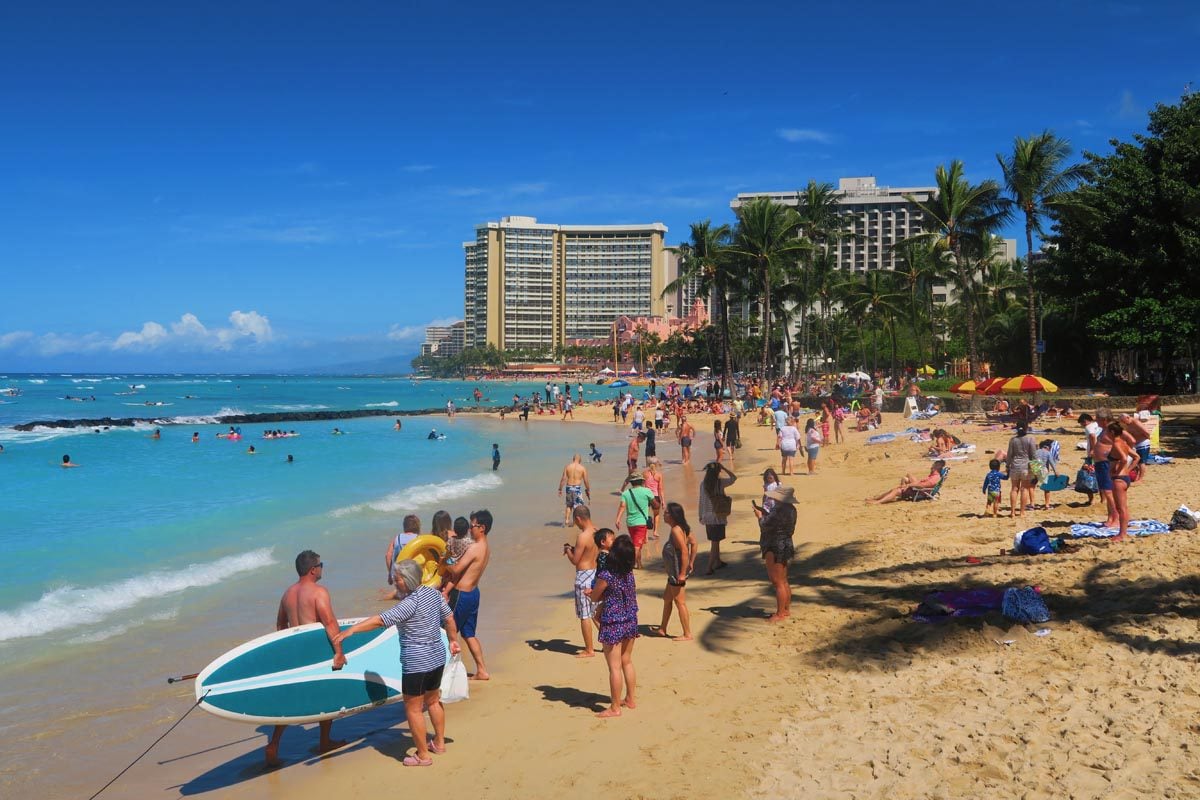
The Beach
Waikiki Beach is comprised of a series of beaches stretching from the Sheraton Waikiki to Queen’s Beach. Some stretches have more sand than others; some are better for surfing and concrete lagoon walls protect some.
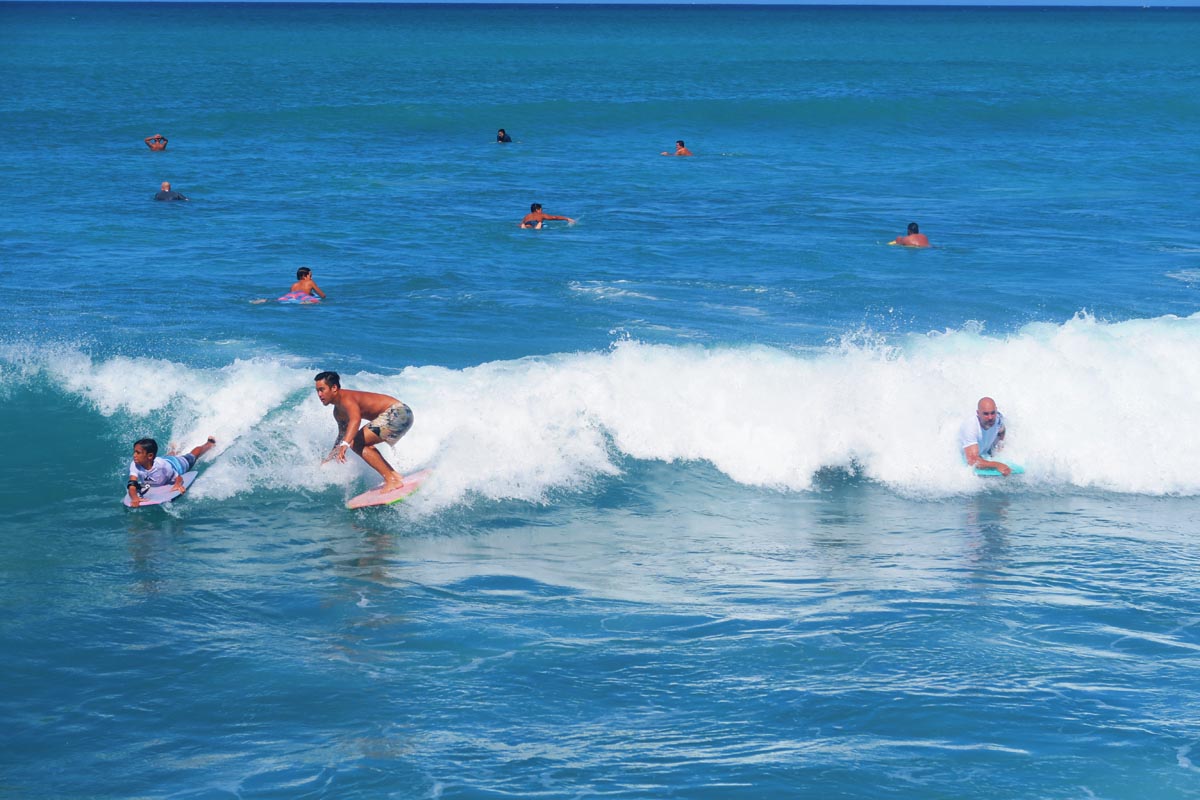
I preferred parking it at Queen’s Beach. While the bottom is a bit rocky and not super comfortable for swimming, the beach – backed by Kapiolani Park – is quieter, and there’s a greater chance to find a (paid) parking space in the Honolulu Zoo lot. It’s also the best spot in Waikiki Beach for watching the sunset!
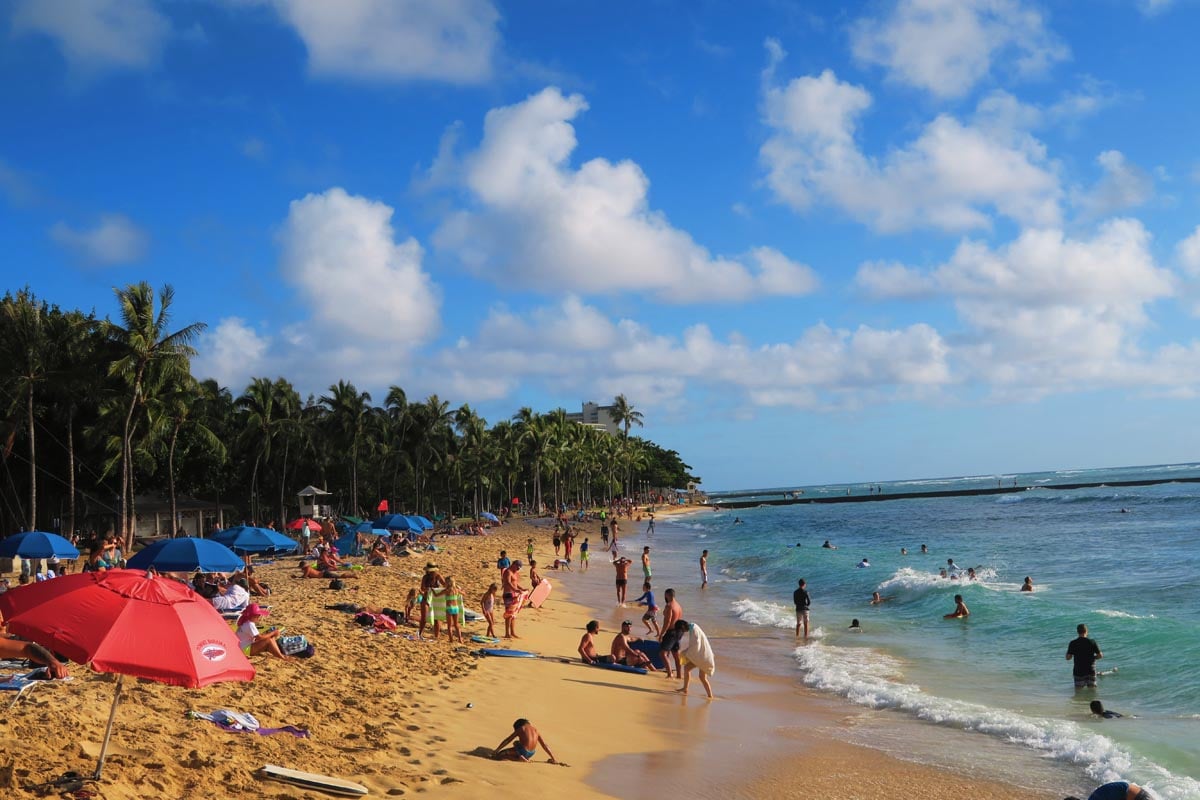
Kalakaua Avenue
Waikiki’s busy thoroughfare, Kalakaua Avenue, connects the series of beaches. Parts of the avenue are a beachfront promenade parallel to Waikiki’s endless hotels and shops. Take your picture with the Duke Kahanamoku Statue – Hawaii’s eternally lei-draped “surfing pioneer” and winner of several Olympic medals in swimming. Then, step inside the historic Moana Surfrider Hotel – the 1901 luxury hotel built in beaux-arts fashion that started the Waikiki hype. Lastly, check out the Royal Hawaiian Hotel – the 1927 art-deco hotel built in Moorish red fashion.

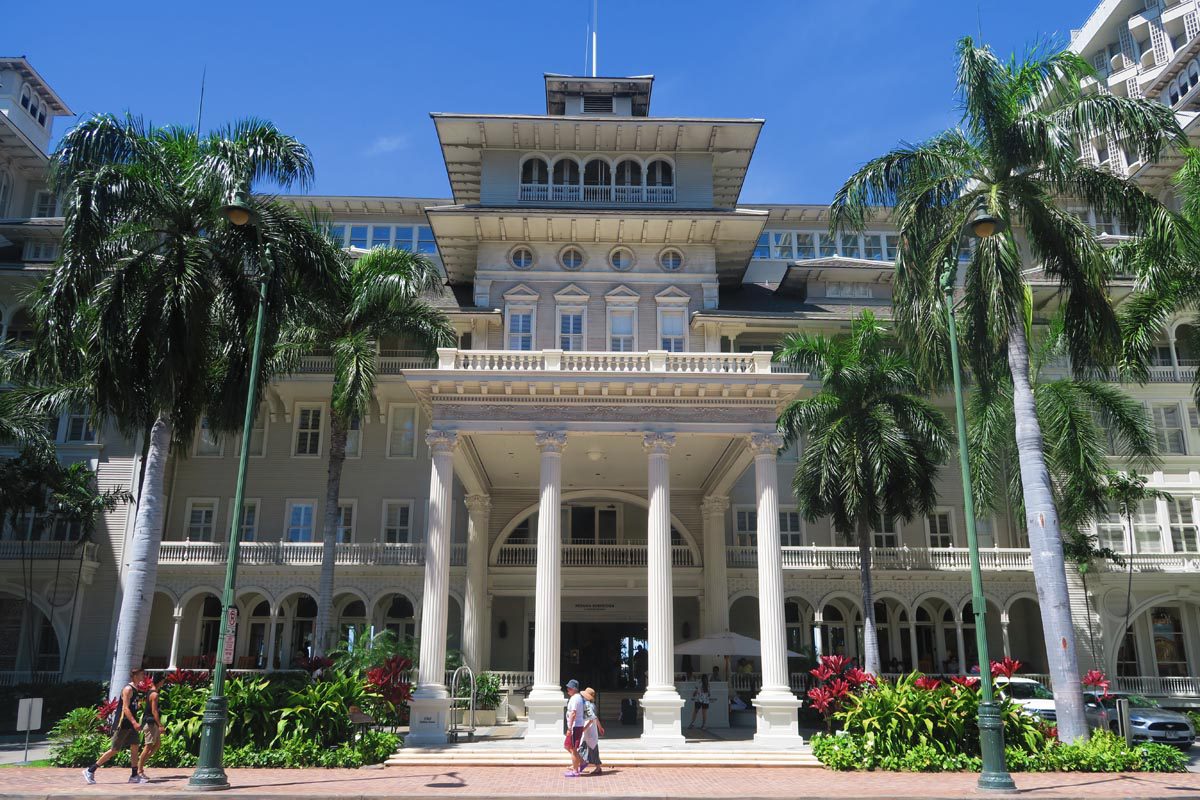
Dinner & Luau Show
Celebrate your first night in Oahu in style with a special buffet dinner and Hawaiian luau show at Ka Moana Luau. Located in an oceanfront property in scenic Makapau’u, your ticket also includes transportation from Honolulu.
